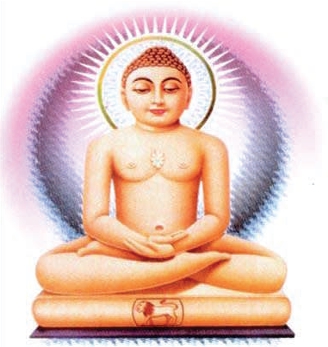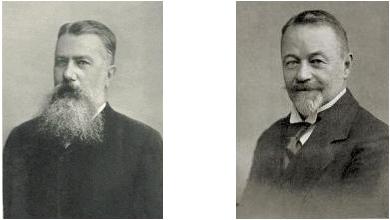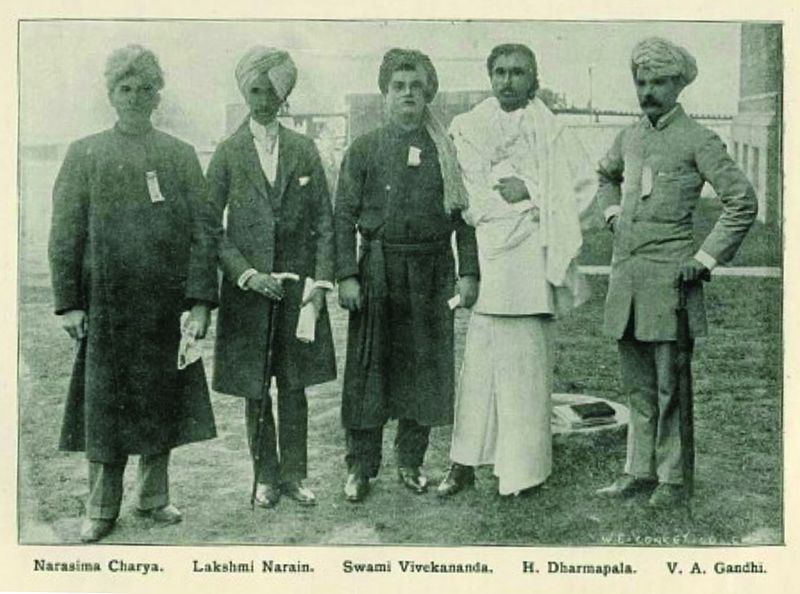
The essay by the eminent research scholar on Jainism Noel Q. King was published in the book Jainism. A Pictorial Guide to the Religion of Non-Violence by Kurt Titze (Delhi: Motilal Banarsidass Publishers Private Limited, 1998, pp. 249-253).
Jaina Dawn in the West
The saga of Western humanity's rise and fall and its life beyond the graves of the two world wars has a deep fascination and is of vital significance for the survival of all. If we were historians of plant pathology studying potato famine, we could try to show how the potato disease which caused the great famines of the nineteenth century was killed by the long sailing ship voyage across the equator but steam ships brought it in a virulent form. [1] We could point to the introduction of another strain and of different storage and transportation facilities as the solution. History of Religions is not as straightforward or as developed a subject but in this essay there is an attempt to set forth an outline history of the knowledge and understanding of and response to Jainism by the peoples of the West from antiquity to the present day. Throughout there is the implication that this religion is an 'exotic' strain which could vivify the incumbent varieties.
Since the days of Alexander, the so-called 'Great', educated Westerners have been fascinated by stories coming in from India about naked mendicants who coveted nothing and were afraid of none. In those stories, with our latter day wisdom, we can hail some of our first news of the Jainas. By the nineteenth century we had learned only a little more. The British officials like H. Th. Colebrooke and missionaries like the Stevenson dynasty and Americans connected with Bombay and Gujarat mission fields begin to tell us more. By the middle of the century, scholars, fascinated by the discovery of the Indo-Germanic theory of languages, were opening up the original texts. German scholars especially made a valuable contribution with their exact and meticulous word studies and their seeking out of scientific etymologies. A parampara, a succession of teachers and disciples, has proliferated and continued to the present day. The British and North Americans continued the work, French and Belgians joined in and a number of distinguished Italians.
It is good to expand a little on the work of two people of German origin who gained pre-eminence at a time when the university in the German world had attained its highest distinction. Dr. Georg Bühler (1837-1898) served fifteen years on the staff of Elphinstone College at Bombay. During these years he personally took part in archaeological field work on Jaina remains and travelled extensively, visiting monasteries and manuscript storehouses to search out the most authentic texts. His health broke down, so he continued his activities in Austria and Germany, encouraging Jainology at all levels. He met death by drowning while still actively engaged in research and teaching.
The other notable scholar is Dr. Hermann Jacobi (1850-1937). He visited India in 1873 and 1913-1914. He not only did some of the most fundamental work towards our truer understanding of Jainism but his two volumes in Max Mueller's Sacred Books of the East, have for over a century placed soundly and sympathetically written Jaina material before Oxford University Press' world-wide English-reading public. Thanks to him the aphorisms of the Jaina sutras have taken a place with the Chinese classics, the Qur'an and the Sanskrit and Buddhist texts. These are but two scholars chosen at random. One could set forward a mighty galaxy of others - German, French, Belgian, Dutch, British, American, Canadian, and Italian - who have done and continue to do distinguished work.

German scholars of Jainology Dr. Georg Bühler (left) and Dr. Hermann Jacobi (right)
Since our subject is concerned with Western perceptions of 'the Jaina radiance', as J. Stevenson the missionary called it in the 1830's, we have spoken only of Western scholars. Of course the real work all along was utterly dependent on Indian co-operation. All the truly great foreign scholars gratefully acknowledge this and of the very nature of the case it could not be otherwise. Just as inevitably our knowledge of Jainism remained mainly a matter for our scholars and therefore was bound to be eurocentric, lacking popular support and as impersonal and objective as possible. Any deep-going and widespread application of Jaina principles to the people's life in general was not yet imaginable. In a way the use of the swastika is an ironic commentary on this. The Jainas have used this symbol in its good luck iconographical form. We used it in reverse form. After being popular with some for a while, to most of us it has become a sign of ill omen. The Jainas still use it, and in the West, when they do so in public, it can produce consternation.
The first breakthrough on a more widespread level was made by a Mr. Virchand Gandhi. The enterprising conveners of the World's Parliament of Religions, due to meet at Chicago in 1893, had sent an invitation to a Jaina muni. [2] Of course his vows did not allow such a journey. The invitation was passed on to a young Jaina layman from Gujarat who was General Secretary of the Jain Association. He was gaining lawyer's qualifications and eventually attained the bar in both India and Britain. He did brilliantly well in a dignified, rational, and undemagogic fashion. He was very different one might say without invidious comparison on either side, from the charismatic and captivating Swami Vivekananda. In its own way the victory of these men was in the religious sphere as clear a word to those who had ears to hear as the sinking of the Russian fleet by the Japanese in 1905. Mr. Gandhi followed up his success at the Parliament by his teaching and writing in America and Britain and gained a number of faithful Western followers. They went ahead, not making many adherents but preparing the ground for what was to come long after their time. Mr. Gandhi himself unfortunately died at the age of 37 in 1901. The community did not produce another such individual apostle and prophet to the West. But the genius of Jainism is finally a community product, not the achievement of any one person.

Svami Vivekananda accompanied by Virchand Gandhi (at the very left)
Inside India, Jainism itself underwent a revolution which has never been fully written up because as with most things Jaina it emanated from the nature of the body and sought as little publicity as possible. From being a withdrawing and retiring community in the shadows of obscure native states and desert places, the Jainas had set up important centres of power and activity in the great cities and in the progressive elements in Indian life. Known as a group who provided hospitals for birds and rescued sacrificial animals, the Jainas became the financiers who helped to topple British imperialism and provide resettlement and a new prosperity for those driven out of Pakistan, Burma, and Uganda. In the professions they took a leading part. Up till recently they did not set up a private university of their own like the Muslim University at Aligarh or the Hindu University at Vanarasi. But everywhere the Jainas gave university leadership with a certain reserved, quiet, noble dignity which is more their style. They of course went deeper and deeper into Jainology in a way with which outsiders find it difficult to compete, though they receive every encouragement from those within. The academic achievement was signaled by a Jaina winning one of the premier Chairs in Indology', as the classicists called it, in the West. In their success and self-confidence the community, still centered in India, is no longer fighting for survival in the face of the outer world. It can perhaps turn more attention to making its teaching known in our world.
The other great new factor has been the establishment of a world-wide Jaina diaspora. In the 1960's economic and legal changes provided a window of opportunity which enabled Jainas to set up communities in Britain, North America, Australia, Malaysia, Thailand, and Hong Kong. Thence perhaps they will spread to Europe, the former Soviet Union, China, and Latin America. Some remain in the earlier Indian diaspora in places like Kenya, Ethiopia and Fiji. The pattern for each settlement seems to be this: Individuals come in, then groups of Jainas gather. Especially as their families arrive, they feel in need of liturgy and teaching as well as social and cultural activity. Lay leaders among them do indeed organize house meetings and conduct services and activities most capably. But still there is a longing for the presence of the monks and nuns. Of course, since most Jainas abroad are professionals or fairly well-to-do business people, air flights home do much to help. But there is need for the presence abroad of Jaina monks and nuns besides Jaina lay men and lay women. Individuals of the mendicant orders are not supposed to travel by any form of mechanical transport. Some of them have dispensed with this provision, justifying their action by the need of the people abroad. Gurudev Chitrabhanu came in 1971 and set up meditation centres over the years. In 1975 Acharya Sushil Kumar (1926-1994), a Sthanakavasi Jaina, came with some monks to the U.S.A. The major ashram he founded is at Siddhachalam in Blairstown, New Jersey.
The Western Jaina communities began to organize centres for worship and study and have united in Associations and Federations. They hope to set up a World Federation. The centres invite and supervise visits and residence by religious specialists. Acharya Tulsi of Ladnun in Rajasthan authorized selected monks and nuns of his community to travel abroad as samanas and samanis, and they too are in great demand to visit and live with Jaina groups in various parts of the world.
The Jainas survived centuries of persecution, genocide, and discrimination perpetrated even by Hindu groups in the days of Shankaracharya and Madhvacharya onwards. Jainas stood in the eye of the storm of the millennial Muslim invasions, yet they survived even in the North West Frontier Province and Sindh till 1947. Partly they survived by avoiding publicity, and by seeking to mingle with the others so as to be inconspicuous. We cannot expect them suddenly to open up to an outer world and shout about themselves, even about the glory of the faith they have preserved. Also they tend to prefer to build temples rather than assist publicity through film or publications or patronage of scholars who are on the fringes and could bring knowledge of the Jainas to outsiders. If they turned their mind to it they could do a great deal to rescue a world which seems to be tottering towards self-destruction. They appreciate the remark that they are dragons guarding a great treasure.
In the meantime the shell of self-sufficiency and imagined superiority which had somehow encapsulated the Western mind had cracked and fallen to pieces. Westerners know the fairest flower of Western civilization had eviscerated itself. They ask whether there is any means of saving a world civilization to which the West has contributed so much from destroying itself. In the study of the Jaina way there are some clues both to the cause of the destruction and to the hope of survival. We may consider some examples, clothing them in everyday terms. The Jainas teach that depending on various factors, the truth may be represented in different ways. More than one way may be right. Therefore we must respect and learn to live with other points of view. Or again, our universe is interdependent, it is not made more for one member such as the human than it is for others, such as animals. Thus kindness is shown to animals not only out of compassion but because any kind of injustice or violence is destructive to the whole and obviously of oneself. Everything is mutually interdependent and co-exists in the whole. Therefore a total and universal sense of responsibility is required of us not only in regard to replacing warfare and violence with fullness of life for all but with regard to proper behavior towards the environment. Humans have to learn to see themselves in their proper and due place, prepared to use only what is necessary and to give up with grace and appropriateness. For some this can include a process of euthanasia which is not suicide, but that is a matter not easy to explain in anything short of a few volumes.
To sum up and conclude. The Jainas are poised at a place in history where their teachings are vitally necessary to world civilization. If they are willing to propagate them world-wide (in the best and early sense in the word), and we are willing to receive and make them our own, there will be a new dawn of purpose for us all, including the insects and bacteria, viruses, and disease syndromes. [3]
It is said the story of King Arthur or of Abelard and Heloise are a paradigm of the European Middle Ages or Dr. Faustus of the Renaissance and Enlightenment. The Jainas have an endless stock of stories with which they have enriched the vernacular literature of the cultures they have entered. We can await the appearance in Western garb of for instance the following gem as recreated by a Jaina producer at Hollywood. A King and Queen had a lovely daughter. With joy and anticipation they made ready for her marriage to the most perfect prince and world conqueror. Immediately after the betrothal and all the ceremonies were over, the Prince went off into the wilderness, threw aside his regalia, plucked out his hair and renounced the world. [4] The Princess followed and did the same and as he found his way into perfection, she too entered there into.
The autor is referring to what happened in Ireland in the 19th century, the country where the famine caused by the potato disease was especially severe [note by Klaus Titze]
The mentioned 'Muni' was Acharya Shrimad Vijaya Anand Suri, also known as Swami Atma Ramji Maharaj or Atmaramji, who was a Śvetāmbara Mūrtipūjaka Tapā Gaccha mendicent leader and an important reformer of Jainism in the late 19th century [Editors HN4U].
The prince in this story is Neminatha, the 22nd Tirthankara, also named Aristanemi. It was the sight of the fenced-in animals meant to be slaughtered and served to the wedding-guests that made him act in this way. Scenes of this legendary story are depicted in the ceiling relief-plaque in front of cell 11 in the Luna-Vasahi shrine at Dilwara on Mount Abu. The Luna-Vasahi is dedicated to Neminatha [note by Klaus Titze].
 Dr. Noel Q. King
Dr. Noel Q. King